The rhizosphere and phyllosphere are the two plant regions, where various microbes inhabit. Besides air, water and soil, plants also provide natural habitats for microbial growth.
Each part of the plant encompasses a variety of microorganisms. And, they may impose positive or harmful effects on the plant’s growth events.
The rhizosphere is the region surrounding the root surface. The plant roots serve as the habitats of different microflora. And, this forms the rhizosphere microbiome.
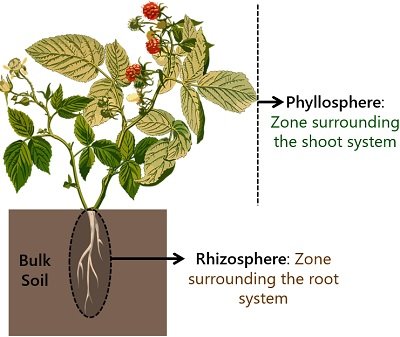
In contrast, the phyllosphere zone covers plants above the ground. The shoot system (leaves, stems, flowers and fruits) provide habitats for microbes. And, microbes inhabiting this region form the phyllosphere microbiome.
Thus, the above two zones constitute the plant microbiome. This post explains the key differences between the rhizosphere and phyllosphere. Also, we will discuss the comparison chart and definition between the two.
Content: Rhizosphere Vs Phyllosphere
Comparison Chart
| Properties | Rhizosphere | Phyllosphere |
|---|---|---|
| Meaning | It is the narrow interface between the root surface and bulk soil | It is the interface between the surface of shoot system and air |
| Discoverer | Lorenz Hiltner in 1904 | Dr. Jakoba Ruinen in 1961 |
| Location | Below the ground surface | Above the ground surface |
| Region | It is the zone surrounding the root system | It is the zone surrounding the shoot system |
| Thickness | Usually have a thickness between 0.39-0.64 mm | Its thickness varies from plant to plant species |
| Subdivisions | Endorhizosphere, Rhizoplane and Ectorhizosphere | Phylloplane, Caulosphere, Anthosphere and Carposphere |
| Exudates | Rhizospheric microbes use root exudates like carbohydrates, amino acids, vitamins etc. | Phyllospheric microbes use leaf exudates like amino acids, glucose, fructose, sucrose etc. |
| Positive effect of microbes | Nutrient management, Plant growth, Plant protection and Rhizosphere bioremediation | Plant protection, Plant growth and Phyllosphere bioremediation |
| Negative effect of microbes | Plant diseases (rot and wilt) | Plant diseases (Blight, rust, spot and wilt) |
| Microbial community | Bacteria, Fungi, Algae and Protists predominate | Bacteria, Fungi, Oomycetes, and Algae predominate |
| Microorganisms | Microorganisms can be aerobic and anaerobic | The majority of microorganisms are aerobic |
Definition of Rhizosphere
The rhizosphere refers to the small portion of soil next to the plant roots. It serves as a reservoir of different microbes. The rhizosphere is the microzone harbouring microbial community. It is a few mm thick zone extending from the root surface. Hiltner introduced the term “Rhizosphere” in 1904. It has the following zones:
- Endorhizosphere is the inner zone. It includes the part of the cortex and epidermis. Here, the microorganisms occupy the apoplastic space.
- F.E. Clark coined the term “Rhizoplane“. It is the surface of the root and root hairs.
- Ectorhizoshere is the outer zone. This layer lies next to the root epidermis.
Plant roots excrete some products in the form of root exudates. These products impose a direct effect on the microbial population within this zone. Rhizosphere biodegradation includes root-associated microbes that degrade recalcitrant organic pollutants by root-associated microbes.
The rhizosphere provides a microenvironment for microbial colonization. It contains both aerobic and anaerobic microorganisms in the vicinity of plant roots.
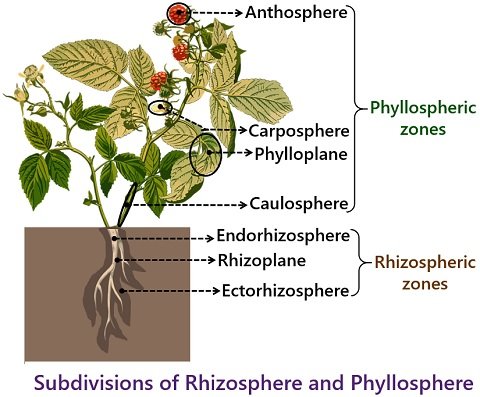
Definition of Phyllosphere
The plant phyllosphere harbours diverse microorganisms around the plant’s aerial parts. Each part of the shoot system, i.e. leaves, stem, flowers, etc., supports distinct microbes’ habitat. Ruinen introduced the term “Phyllosphere” in 1961. The phyllosphere comprises the following zones:
- Phylloplane: Leaves occupy most of the plant’s aerial surface. And the surface of leaves colonized by the microbial community represents phylloplane. It nurtures epiphytic bacterial communities.
- Caulosphere: It is the zone around the stem supporting microbial habitation.
- Anthosphere: It is the layer around flowers colonized by microorganisms.
- Carposphere: It is the zone surrounding fruits, where the microorganisms inhabit.
Epiphytes are the colonists of the phyllosphere. Fungi, algae, protozoa, and nematodes inhabit the leaf and stem surfaces. But, bacteria are the most abundant epiphytes.
Phyllosphere only surrounds the aerial parts of the plant or the shoot system. The microbial community near the surface of the phyllosphere forms the phyllosphere microbiome.
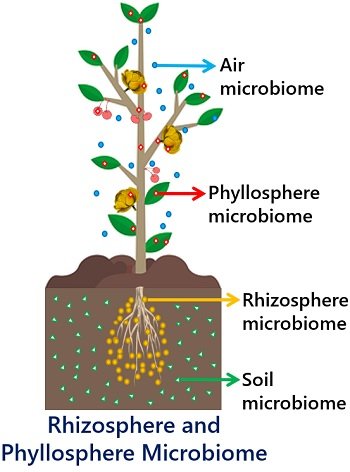
Related Questions
We will answer the frequently asked questions related to the given context.
Q1. How is the Rhizosphere different from Non-rhizosphere soil?
The rhizosphere is the soil layer right next to the plant root surface. In contrast, non- rhizosphere or bulk soil is the zone found away from the root system.
Q2. How is Phyllosphere different from Endosphere?
Epiphyte organisms populate the phyllosphere. They inhabit the exposed surfaces of plants. In contrast, the endosphere forms zones for the microbes to live inside the plant tissues. Such organisms are called endophytes.
Q3. Is Rhizoplane different from the term Rhizosphere?
Rhizoplane is the zone around the plant roots and root hairs. It is in close contact with the soil particles of the rhizosphere.
Or, we can say that rhizoplane lies between the endo and ecto-rhizospheres. The microbes adhere to the rhizoplane via appendages like flagella, fimbriae etc.
In contrast, the rhizosphere is a thin layer of soil lying next to the rhizoplane. This layer provides a habitat for diverse microorganisms. Also, it is an active area for root activity and metabolism.
Q4. Is Phylloplane different from the term Phyllosphere?
Phylloplane is the zone around the surface of leaves. It is one of the parts of the phyllosphere.
In contrast, the phyllosphere is the zone covering the whole shoot system. Here, the surface of stems, flowers and fruits provide microbial habitation.
It is in close contact with the air microbiome. Or, we can say that the phyllosphere lies between the surface of the shoot system and the air microbiome.
Q5. How does the Rhizosphere support a large number of Microorganisms?
According to the research, the rhizosphere supports more microorganisms than the bulk soil. The reasons for supporting microbial growth are:
- Plant roots release a large amount of organic carbon, necessary for microbial growth.
- Root exudates provide nutrient sources for the microbes inhabiting the rhizosphere. Roots excrete products like sugars, amino acids, organic acids, vitamins etc.
Q6. What are Rhizosphere Microorganisms?
The rhizosphere microorganisms represent organisms associated with the surface of the plant root system. These may impose good or bad effects on the plant.
Bacteria, fungi, nematodes, protozoa, algae and microarthropods constitute the rhizosphere microbiome. But, there is more population of bacteria and fungi species.
- Bacteria: Azospirillum, Anthrobacter, Bacillus, Rhizobium, Mycobacterium species etc.
- Fungi: Mycorrhizal fungi and pathogenic fungi (Phytophthora, Fusarium, Aspergillus species etc.
- Actinomycetes: Nocardia, Streptomyces, Micromonospora species etc.
- Algae: Chlorella, Chlamydomonas species etc.
- Protozoans: Heterodera, Pectus, Tylenchus species etc.
The picture below depicts the beneficial and harmful effects of the rhizosphere microorganisms.
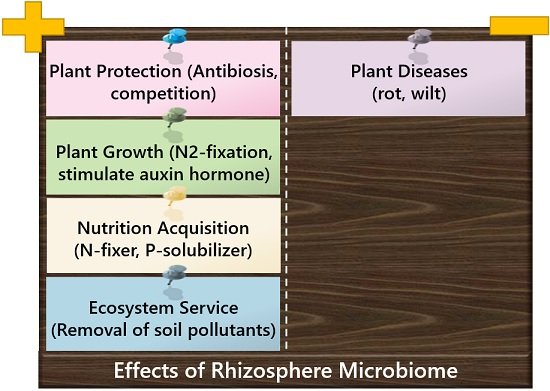
Q7. What are Phyllospheric Microorganisms?
The phyllosphere microorganisms are associated with the plant shoot system. These can be beneficial or harmful for the plant.
The leaf surface contains a large number of bacteria, fungi, actinomycetes and algae. But, the population of bacteria and fungi predominate.
- Bacteria: Beijerinckia, Erwinia, Azotobacter, Pseudomonas, Serratia species etc.
- Fungi: Alternaria, Cercospora, Penicillium, Saccharomyces, etc.
- Blue-green algae: Anabaena, Calothrix, Nostoc species etc.
- Actinomycetes: Streptomyces sp.
The picture below indicates the positive and negative effects of phyllosphere microorganisms.
Key Differences Between Rhizosphere and Phyllosphere
- The rhizosphere is the narrow interface between the root surface and bulk soil. Thus, the location is below the ground surface. In contrast, the phyllosphere is between the interface of the shoot system and the air. Thus, the area is above the ground surface.
- The rhizospheric microbiome surrounds the root system with a 0.39-0.64 mm thickness. In contrast, the phyllosphere microbiome covers the shoot system with varying thicknesses.
- The endorhizosphere, rhizoplane and ectorhizosphere are three zones of the rhizosphere. Phylloplane, Caulosphere, Anthosphere and Carposphere are the zones constituting phyllosphere.
Conclusion
Rhizosphere and phyllosphere are the zones encouraging plant and microbial interaction. These are the regions where plant growth-promoting microorganisms and pathogens inhabit. Thus, the microbes residing within these zones can cause positive and negative effects.
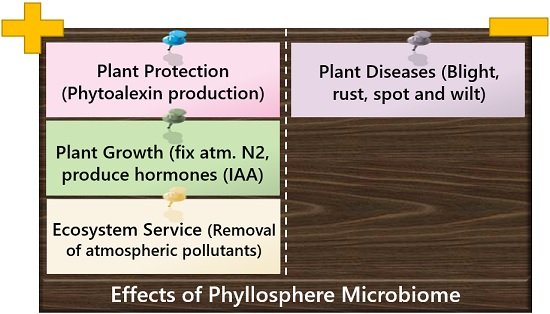
I like your website because I am a biology teacher and I have 8 years of experience in the field of biology. I like to study more and more about biology and its other fields.